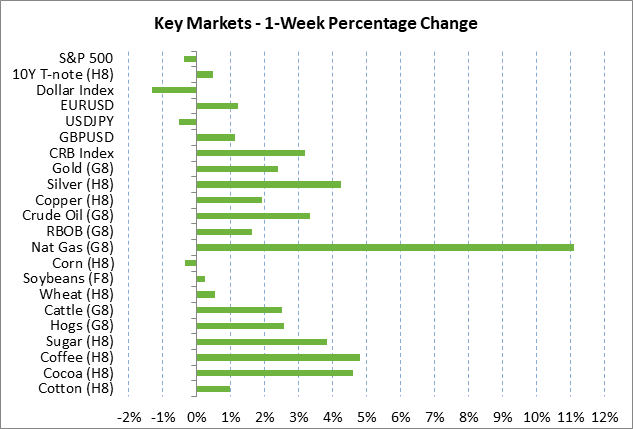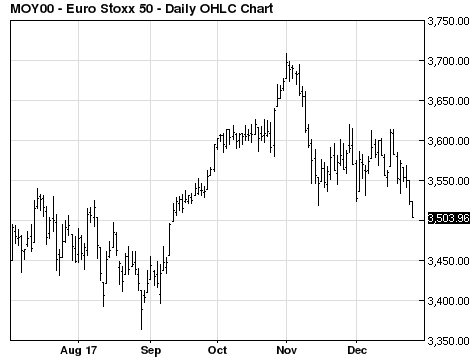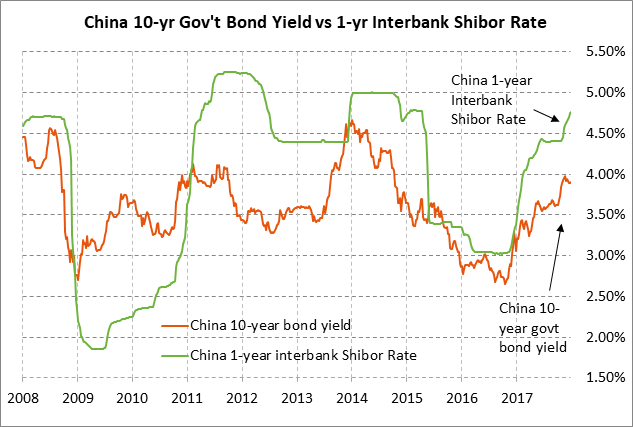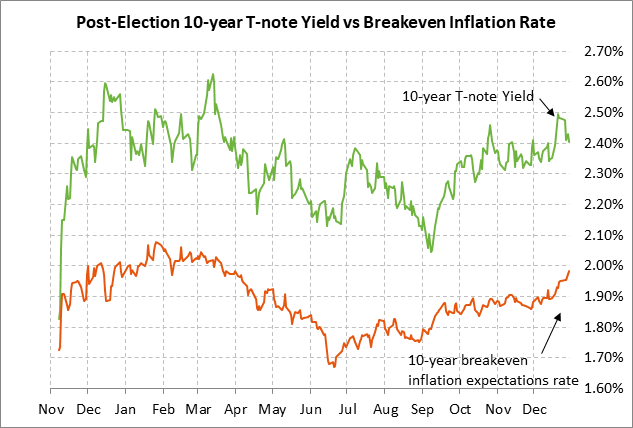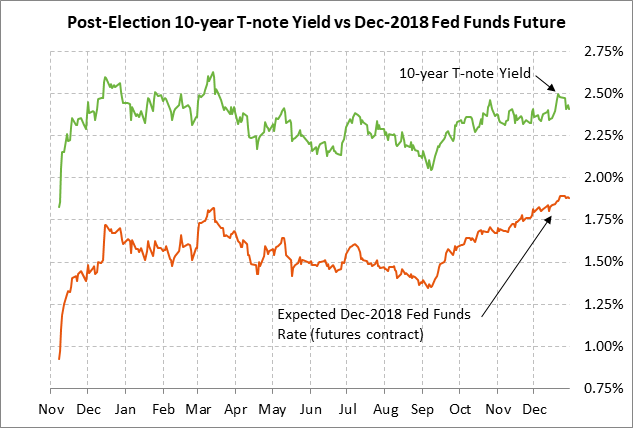- Weekly global market focus
- U.S markets begin the new year with focus on economic data and possible government shutdown
Weekly global market focus — This week’s U.S. economic schedule is fairly busy with highlights including Wednesday’s ISM manufacturing index (expected unchanged at 58.2) and Friday’s Dec payroll report (expected +188,000). There are only six of the S&P 500 companies that report earnings this week, but the full Q4 earnings season begins in just two weeks. The new Republican tax law has taken effect and the markets will be watching its impact on after-tax earnings and repatriation of overseas corporate cash.
Congress will be back in session this Wednesday (Jan 3) after their holiday recess. Congress has only 2-1/2 weeks to pass new spending authority and prevent a government shutdown before the current continuing resolution expires on Jan 19. There is the distinct threat of a government shutdown this time around since Republicans and Democrats are at loggerheads on a range of issues including top-line funding for defense and non-defense spending, a dreamer solution, border wall funding, the bipartisan Obamacare fix that was promised to Senator Collins, an extension of foreign surveillance authority, disaster relief, and other issues.
The Republican majority in the Senate will be down to 51-49 from 52-48 once Democrat Doug Jones is seated as the next Senator from Alabama. Alabama election officials last Thursday certified Mr. Jones as the winner. The thinner Republican majority in the Senate will make it even more difficult for Majority Leader McConnell to win any legislative victories in 2018 without the support of some Democrats.
The “Big Four” congressional leaders (Ryan, Pelosi, McConnell, Schumer) will meet this Wednesday with White House officials, according to Politico. White House officials attending the meeting will include legislative affairs director Marc Short, budget director Mick Mulvaney, and possibly Chief of Staff John Kelly. President Trump will not attend the meeting, according to Politico. The discussion will focus on a deal to prevent a government shutdown and immigration issues.
President Trump is scheduled to meet with House Speaker Ryan and Senate Majority Leader McConnell at Camp David this coming weekend (Jan 6-7) to discuss the Republican’s 2018 legislative agenda. President Trump wants to move ahead with an infrastructure bill and the Ryan plan for cuts to welfare and entitlements. House-Senate Republicans will hold their annual policy retreat starting on Jan 31 at The Greenbrier.
The markets starting this week will be watching for any new Fed appointments by President Trump. There were media reports last Thursday that the White House interviewed Pimco Managing Director Richard Clarida and economist Lawrence Lindsey for the Fed Vice Chair position. The WSJ reported that former Pimco CEO Mohamed El-Erian is also under consideration for the Vice Chair position.
The Senate is expected to soon confirm Jerome Powell as the new Fed Chair to take over when Ms. Yellen’s term expires on Feb 3. President Trump has already nominated Marvin Goodfriend as a Fed Governor, but he has yet to be confirmed by the Senate. President Trump must nominate two more Fed Governors for an empty seat and to replace Ms. Yellen when she leaves the Fed in February.
Meanwhile, the FOMC will turn a bit more hawkish in 2018 now that doves, Chicago Fed President Evans and Minneapolis Fed President Kashkari, have rotated out of a voting position in 2018. The FOMC’s latest forecast is for three +25 bp rate hikes in 2018 totaling +75 bp, which would take the funds rate target to 2.00-2.25% by the end of 2018 from the current level of 1.25-1.50%. The markets, however, are expecting only two +25 bp rate hikes in 2018.
In Europe, the focus this week will be on stocks as the Euro Stoxx 50 index last Friday fell to a new 3-3/4 month low. The ECB’s QE program this month will be cut to 30 billion euros per month from the 2017 pace of 60 billion euros. The new MiFID II investment-industry rules on research and trading become effective on Wednesday, Jan 3. The European markets will closely follow the Italian political polls ahead of the March 4 election. The polls suggest that the outcome of the election will be a hung Parliament since the three main political groups (Five Star Movement, center-left led by the Democratic Party, and the center right led by Forza Italia) are all bunched together in the opinion polls.
In Asia, the Japanese markets are closed today for a bank holiday. This past Saturday’s Chinese PMI reports were neutral to slightly bearish. The Dec manufacturing PMI report of -0.2 to 51.6 was in line with market expectations but the Dec non-manufacturing PMI report of -0.1 to 54.7 was weaker than expectations of +0.2 to 55.0. In a positive development, China’s Shanghai Composite stock index last Friday rallied to the upper end of the 3-week consolidation range. Meanwhile, the Chinese 10-year bond yield has moved sideways in the past two weeks near 3.90%.
U.S markets begin the new year with focus on economic data and possible government shutdown — The U.S. stock and bond markets this week will focus mainly on (1) key economic data such as Wed’s ISM report and Friday’s unemployment report, and (2) whether there will be a government shutdown in 2-1/2 weeks when the CR expires. Stocks start the year at elevated valuation levels with the focus on expectations for another year of strong earnings and a positive impact of the Republican tax-cut law. March 10-year T-note prices rebounded mildly higher late last week but remain under medium-term pressure from the Fed’s expected rate hikes this year as well as rising inflation expectations. The 10-year breakeven inflation expectations rate has risen sharply by 10 bp in the past two weeks and posted a new 9-month high of 1.98% last Friday.
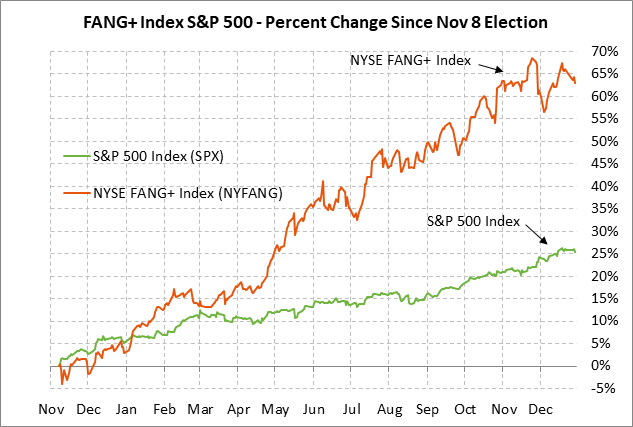
Weekly global market focus — This week’s U.S. economic schedule is fairly busy with highlights including Wednesday’s ISM manufacturing index (expected unchanged at 58.2) and Friday’s Dec payroll report (expected +188,000). There are only six of the S&P 500 companies that report earnings this week, but the full Q4 earnings season begins in just two weeks. The new Republican tax law has taken effect and the markets will be watching its impact on after-tax earnings and repatriation of overseas corporate cash.
Congress will be back in session this Wednesday (Jan 3) after their holiday recess. Congress has only 2-1/2 weeks to pass new spending authority and prevent a government shutdown before the current continuing resolution expires on Jan 19. There is the distinct threat of a government shutdown this time around since Republicans and Democrats are at loggerheads on a range of issues including top-line funding for defense and non-defense spending, a dreamer solution, border wall funding, the bipartisan Obamacare fix that was promised to Senator Collins, an extension of foreign surveillance authority, disaster relief, and other issues.
The Republican majority in the Senate will be down to 51-49 from 52-48 once Democrat Doug Jones is seated as the next Senator from Alabama. Alabama election officials last Thursday certified Mr. Jones as the winner. The thinner Republican majority in the Senate will make it even more difficult for Majority Leader McConnell to win any legislative victories in 2018 without the support of some Democrats.
The “Big Four” congressional leaders (Ryan, Pelosi, McConnell, Schumer) will meet this Wednesday with White House officials, according to Politico. White House officials attending the meeting will include legislative affairs director Marc Short, budget director Mick Mulvaney, and possibly Chief of Staff John Kelly. President Trump will not attend the meeting, according to Politico. The discussion will focus on a deal to prevent a government shutdown and immigration issues.
President Trump is scheduled to meet with House Speaker Ryan and Senate Majority Leader McConnell at Camp David this coming weekend (Jan 6-7) to discuss the Republican’s 2018 legislative agenda. President Trump wants to move ahead with an infrastructure bill and the Ryan plan for cuts to welfare and entitlements. House-Senate Republicans will hold their annual policy retreat starting on Jan 31 at The Greenbrier.
The markets starting this week will be watching for any new Fed appointments by President Trump. There were media reports last Thursday that the White House interviewed Pimco Managing Director Richard Clarida and economist Lawrence Lindsey for the Fed Vice Chair position. The WSJ reported that former Pimco CEO Mohamed El-Erian is also under consideration for the Vice Chair position.
The Senate is expected to soon confirm Jerome Powell as the new Fed Chair to take over when Ms. Yellen’s term expires on Feb 3. President Trump has already nominated Marvin Goodfriend as a Fed Governor, but he has yet to be confirmed by the Senate. President Trump must nominate two more Fed Governors for an empty seat and to replace Ms. Yellen when she leaves the Fed in February.
Meanwhile, the FOMC will turn a bit more hawkish in 2018 now that doves, Chicago Fed President Evans and Minneapolis Fed President Kashkari, have rotated out of a voting position in 2018. The FOMC’s latest forecast is for three +25 bp rate hikes in 2018 totaling +75 bp, which would take the funds rate target to 2.00-2.25% by the end of 2018 from the current level of 1.25-1.50%. The markets, however, are expecting only two +25 bp rate hikes in 2018.
In Europe, the focus this week will be on stocks as the Euro Stoxx 50 index last Friday fell to a new 3-3/4 month low. The ECB’s QE program this month will be cut to 30 billion euros per month from the 2017 pace of 60 billion euros. The new MiFID II investment-industry rules on research and trading become effective on Wednesday, Jan 3. The European markets will closely follow the Italian political polls ahead of the March 4 election. The polls suggest that the outcome of the election will be a hung Parliament since the three main political groups (Five Star Movement, center-left led by the Democratic Party, and the center right led by Forza Italia) are all bunched together in the opinion polls.
In Asia, the Japanese markets are closed today for a bank holiday. This past Saturday’s Chinese PMI reports were neutral to slightly bearish. The Dec manufacturing PMI report of -0.2 to 51.6 was in line with market expectations but the Dec non-manufacturing PMI report of -0.1 to 54.7 was weaker than expectations of +0.2 to 55.0. In a positive development, China’s Shanghai Composite stock index last Friday rallied to the upper end of the 3-week consolidation range. Meanwhile, the Chinese 10-year bond yield has moved sideways in the past two weeks near 3.90%.
U.S markets begin the new year with focus on economic data and possible government shutdown — The U.S. stock and bond markets this week will focus mainly on (1) key economic data such as Wed’s ISM report and Friday’s unemployment report, and (2) whether there will be a government shutdown in 2-1/2 weeks when the CR expires. Stocks start the year at elevated valuation levels with the focus on expectations for another year of strong earnings and a positive impact of the Republican tax-cut law. March 10-year T-note prices rebounded mildly higher late last week but remain under medium-term pressure from the Fed’s expected rate hikes this year as well as rising inflation expectations. The 10-year breakeven inflation expectations rate has risen sharply by 10 bp in the past two weeks and posted a new 9-month high of 1.98% last Friday.

